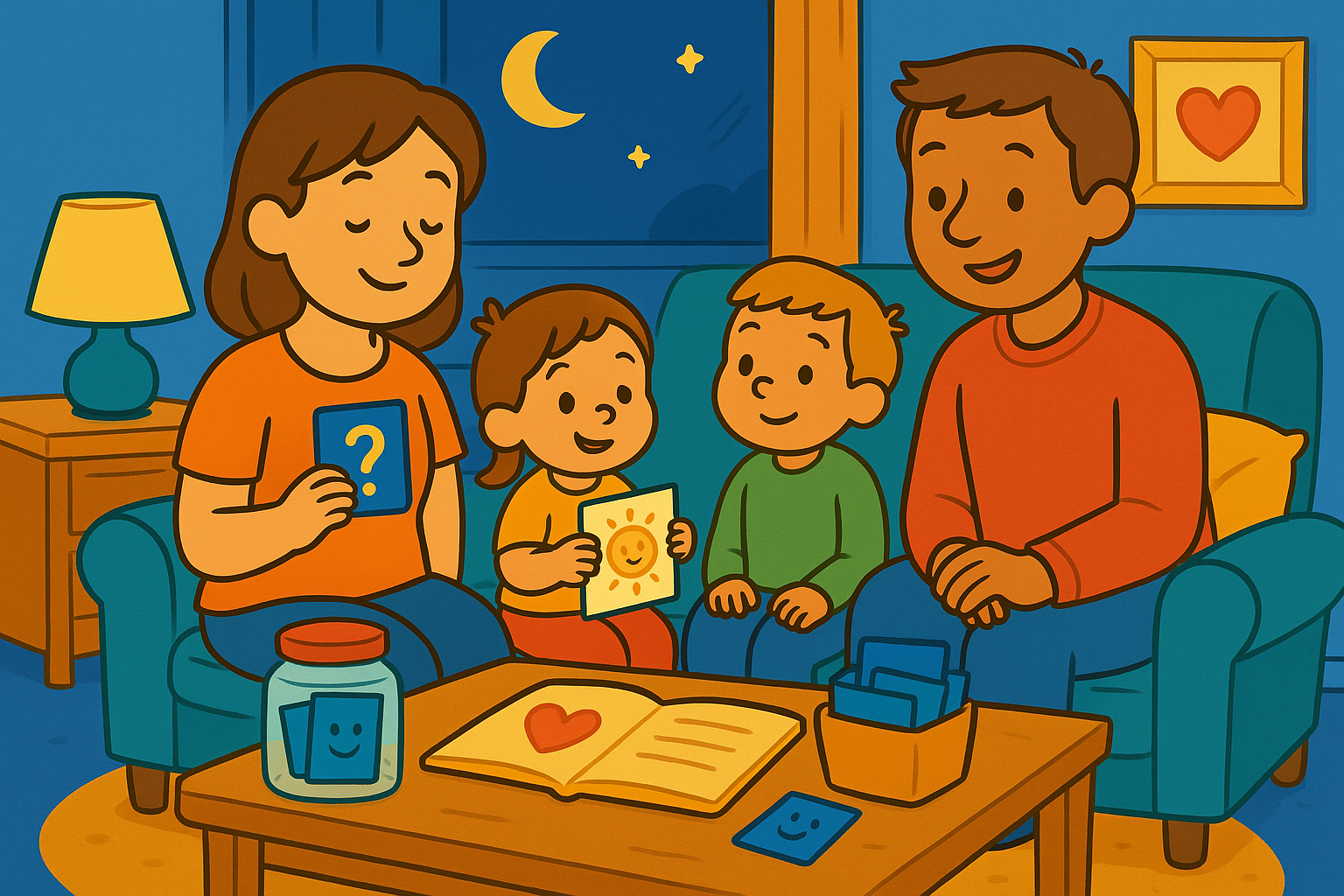Family Evening Reflection Prompts
Family Evening Reflection Prompts
Evenings are powerful moments for connection. They offer space to process the day, slow down, and remember that a family is not just people living together — it is people growing together. Evening reflection prompts help children put their thoughts into words and understand their day with more clarity and confidence. These simple conversations teach children to notice their feelings, honor their efforts, and see themselves as learners, not just doers.
Evening reflection doesn’t need to be long or formal. A few thoughtful prompts at the end of the day can help build emotional intelligence, trust, and the self-awareness that leads to lifelong resilience.
Why Evening Reflection Matters
Reflection allows children and adults to pause and understand their inner world. Without reflection, emotions get carried into the next day. With reflection, feelings can rest — and space opens for growth.
Evening reflection helps:
Reduce bedtime anxiety
Improve emotional expression
Strengthen memory of positive moments
Close the day with connection
Support long-term emotional strength
Reflection turns ordinary moments into meaningful ones.
Creating the Right Atmosphere
Reflection works best when the environment feels calm and safe. This connects with ideas in How to Transition Kids From Playtime to Bedtime Calmly, where sensory cues guide the shift into rest.
Consider using:
Dim lighting or lamps
Soft blankets or quiet corner
Gentle grounding music
Slow breathing before talking
Cozy sitting areas
A peaceful environment sends a message: It’s safe to share here.
The Power of Simple Prompts
Children don’t need complex questions — they need accessible ones. Simple wording leads to honest answers.
Helpful prompts include:
“What was the hardest part of today?”
“What made you smile?”
“What helped your body feel calm?”
“Was there something you wish went differently?”
“What do you feel proud of today?”
Short questions can open long conversations.
Reflection Prompt Cards or Jars
Making reflection tangible helps children engage. Similar to ideas in Family Gratitude Jars and Journals, visuals make the process playful and approachable.
Ways to use prompts:
Reflection jar with folded prompts
Picture cards with facial expressions
Dice with different reflection themes
Draw-your-feeling cards
Bedtime spinner for questions
Hands-on tools prevent reflection from feeling like a quiz.
Using Emotions as a Guide
Emotions are often easier to talk about when children learn to name them. Naming brings clarity — and clarity brings calm.
Emotion-based prompts:
“What made you feel brave today?”
“Did you feel frustrated? What helped?”
“Was there a moment you wished for help?”
“When did you feel excited?”
“How did your body feel when you were nervous?”
Over time, children learn that emotions are guides — not problems.
Encouraging Family Participation
Reflection shouldn’t be one-directional. When parents and siblings share too, children feel more comfortable opening up. This mirrors strategies seen in Family Communication Rituals for Stronger Bonds, where shared dialogue builds trust.
Ways to invite participation:
“Let’s all share one rose and one thorn.”
“Who wants to start tonight?”
“I had a challenge today too…”
Rotate who picks a prompt
Model vulnerability as a strength
When adults share, children feel less alone.
When Children Don’t Want to Talk
There will be evenings when conversation feels difficult. That’s okay. Reflection should feel gentle — never forced.
Alternatives to verbal sharing:
Drawing feelings
Using puppets or toys to explain
Whispering answers
Writing notes
Typing feelings into a device
Silence sometimes still communicates comfort — even without words.
Short Rituals to End Each Day
Adding a closing ritual helps children mentally “land” before sleep. This gives them something consistent to look forward to each night.
Closing ritual ideas:
Three deep breaths together
“One thing I’m thankful for” moment
Predictable phrase: “Tomorrow is a new day.”
Sign language goodnight signal
One-minute hand massage or shoulder press
These repeated cues create security — even on difficult days.
Building Emotional Memory
Reflection helps children remember important moments instead of letting them disappear. This builds emotional awareness and long-term confidence.
Ways to honor memories:
Memory journal
Wall calendar with meaningful events
“Look how far we’ve come” board
Before/after drawings of improvements
Voice notes or videos
Reflection keeps the day alive — even when it’s over.
Adjusting Prompts for Age
Prompts evolve as children develop emotional awareness and vocabulary.
Age-based ideas:
Toddlers: picture cards (“happy,” “sad,” etc.)
Preschoolers: one-word prompts or simple questions
Early elementary: roses & thorns + choices
Older kids: self-led reflection questions
Teens: sections of journal or reflection app
Reflection grows with the child — but the heart of it remains the same.
When Reflection Becomes a Source of Strength
Over time, reflection turns into a habit — and habits form identity. Children begin to understand that their feelings matter, their efforts are seen, and every day has something worth remembering.
And that is what turns a simple evening conversation into lifelong resilience — one prompt at a time.
This content is for educational purposes and is not a substitute for professional medical or psychological advice.
Popular Parenting Articles


